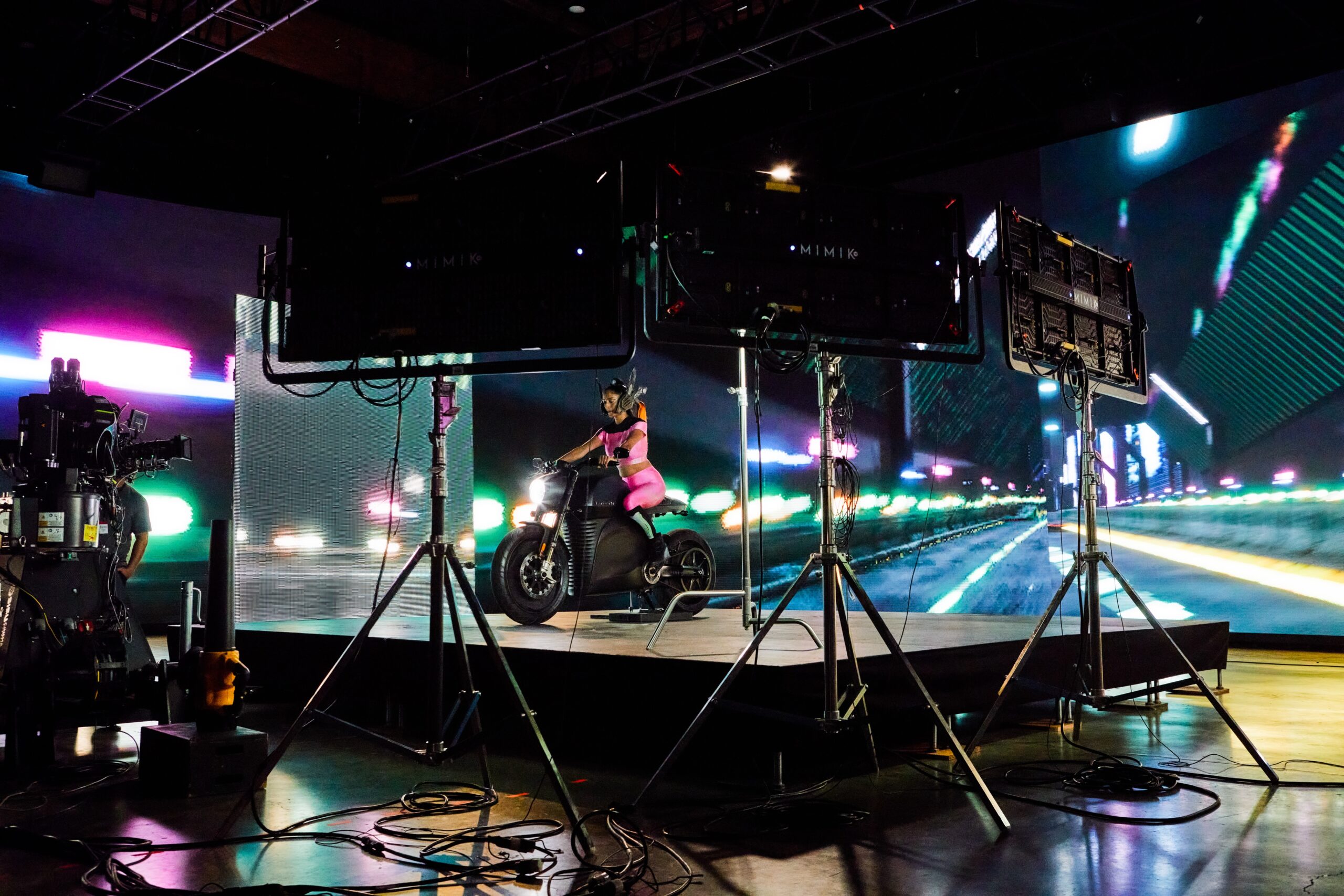Fearless Productions’ Project Chimera shines with Kino Flo’s MIMIK 120

Kino Flo Lighting Systems has announced that its MIMIK 120 full-spectrum, image-based video lighting tile was utilized by Hollywood-based digital film production company Fearless Productions in Project Chimera — a music video designed to demonstrate the capabilities of the very latest in virtual production technology.
For the video, Fearless Productions utilized a variety of MIMIKs in different configurations on a virtual production LED stage to light talent and a Tarform electric motorcycle with full-spectrum color, creating a more realistic and immersive viewing experience.
Set to drum and bass electronic music by Janaka Selekta, Project Chimera combines an action storyline with an abstract interpretation of a classical Indian dance performance — all set in a cyberpunk future — to tell the story of a love triangle. Filmed on a virtual production stage at Fuse Technical Group, the video was shot with RED Komodo 6K digital cinema cameras with Fujinon Premistas zoom lenses. It also showcases a wide range of cutting-edge technologies for the creation of AR objects, camera tracking, and motion control, with Kino Flo’s MIMIK 120 synchronizing lighting on the virtual set with Unreal Engine content playing on the LED volume.
Optimized for virtual production environments and for delivering extended spectral bandwidth and cinematic color fidelity when lighting talent and set elements the patented Kino Flo Matchmakker algorithm converts the incoming RGB video wall signal into four or more individual emitters — RGB-WW-CW for the MIMIK 120 — generating synchronized foreground lighting that delivers the utmost realism on virtual sets, including natural skin tones and accurate renderings of colorful costumes.
“With Project Chimera, our goal was to show how technology can bring the unimaginable to life — through the video and a series of short documentary videos showing how we did it,” said Snehal Patel, director and producer at Fearless Productions. “Representing a monumental leap forward in virtual production lighting, the MIMIK 120 played a key role. In addition to providing higher brightness and better spectral response curves than LED walls, the MIMIK actually uses the content on the LED volume to light actors and foreground objects. This gives the gaffer and cinematographer a whole new toolset to utilize, allowing them to deliver unprecedented realism that completely immerses viewers into the cyberpunk world we’ve created.”
Delivering 10,000-nits brightness, the adaptable MIMIK 120 is designed to be stacked like a video wall, flown as a ceiling, or put on traditional lighting rigs. For Project Chimera, Fearless Productions utilized eight panels in an 8-foot-by-8-foot video wall configuration — featuring a ground support system that allowed it to be easily moved to meet the needs of the shot — while eight additional units were mounted on separate mobile lighting rigs. The lighting system is controlled by the Megapixel VR HELIOS LED processor.
“With control via a Megapixel Helios processor, the MIMIK 120 integrates seamlessly into the world of virtual production,” added Patel. “We were able to use the same processor and interface for the lighting system and LED volume, which allowed us to work far more efficiently. Using the processor, all we had to do was route video data throughout the lighting system over Ethernet, sending different pieces of background content to different panels to get the exact look we wanted. As a result, we were able to change setups very quickly. Over a two-day period, that allowed us to complete a staggering 86 shots, and was essential to our completing the project on time and under budget. We already have a variety of additional projects lined up for the panels, including virtual production, volumetric filming on a 3D capture stage, and practical driving shots.”
“By mimicking what’s on the LED volume, Kino Flo’s MIMIK 120 represents a huge leap forward in lighting for virtual production — the difference it makes in terms of light interactivity and the verisimilitude of the image can’t be overstated,” said project cinematographer Robert McLachlan, ASC, CSC. “I can see it being especially useful in driving shots, by providing cinematographers with complete control over reflections in windows instead of relying on compositors, who don’t always know how pronounced reflections should be.”
Subscribe to NCS for the latest news, project case studies and product announcements in broadcast technology, creative design and engineering delivered to your inbox.




Categories
Industry Feed, News and Entertainment Production Systems
The content on this page is provided by the featured companies. NewscastStudio cannot guarantee the accuracy or veracity of any claims about products or services made in this content. The views expressed in this content do not necessarily reflect the views of NewscastStudio or its team. This content may contain trademarks owned by third parties, and those marks are the property of those companies.